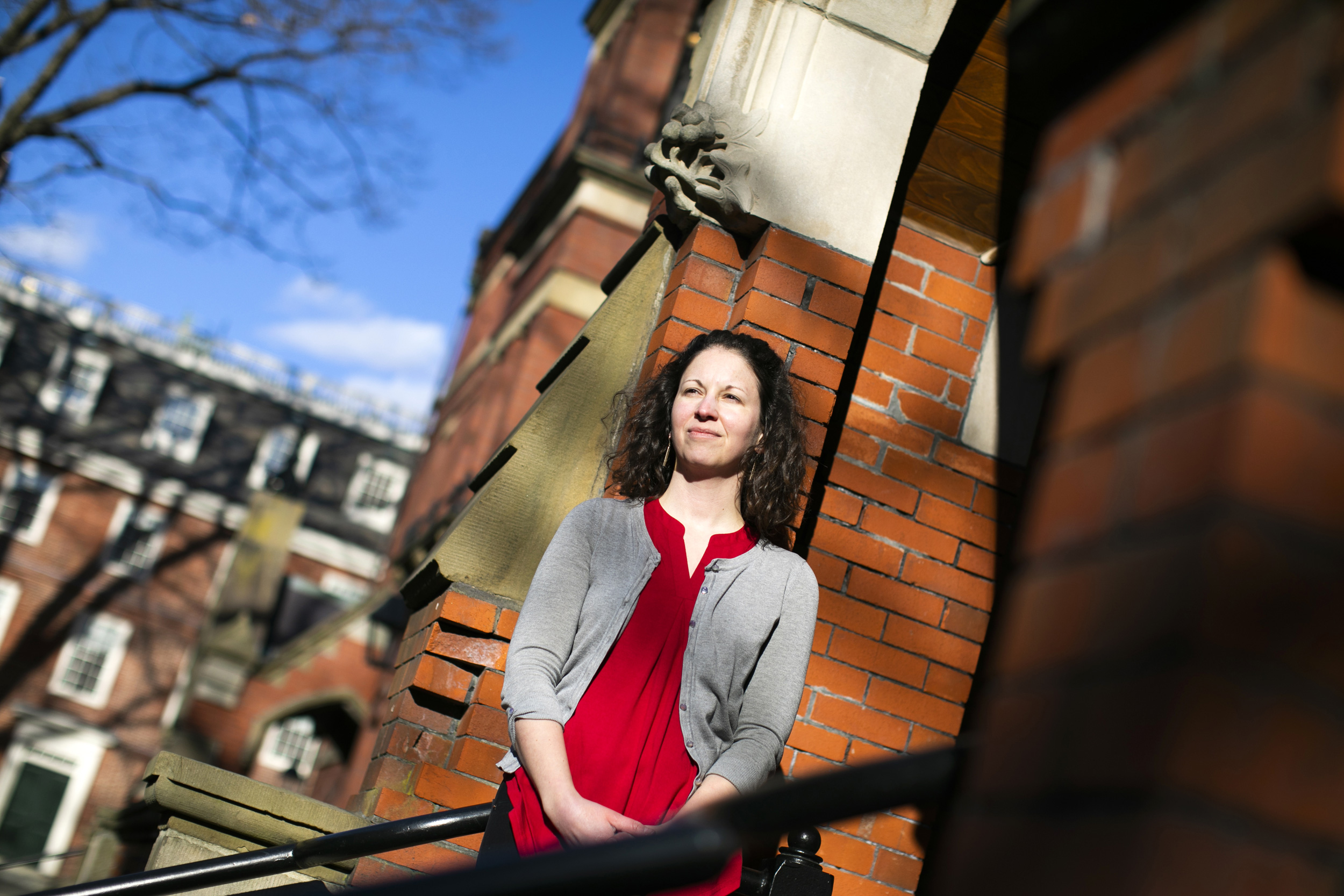
During her field research, Jessica Katzenstein says that officers explained the distinction between good and bad militarization.
Stephanie Mitchell/Harvard Staff Photographer
Why police resist reforms to militarization
Issues revolve around culture of viewing civilians as potential threats, concerns about self-protection in departments equipped with military-grade arms
The mass shooting in Uvalde, Texas, last year by a gunman armed with an AR-15-style rifle resulted in a searing loss of life — 19 young students and two teachers at Robb Elementary School. But equally stunning was the 77 minutes it took police to respond, despite having adequate firepower, equipment, and training to do so. The delay turned a spotlight on the militarization of U.S. law enforcement, how it can fail to protect individuals from the kinds of threats it was intended to thwart, and its tendency to foster a culture of self-protection that can result in unnecessarily violent or deadly responses, particularly in communities of color.
The issue is complex, and many law enforcement departments across the country have continued to resist reforms even amid a rising crisis of confidence in police and concerns over racism in the ranks. Jessica Katzenstein, an Inequality in America fellow who recently completed her Ph.D. in anthropology at Brown, has been analyzing police militarization in an effort to show how and why departments are resisting changes and the ways this resistance is not as straightforward as it’s often portrayed.
Put simply, police militarization consists of a decades-old federal government practice of making military equipment available to state and local law enforcement departments. The initial intent was to help arm police in the war on drugs and later to prevent terror attacks. Katzenstein said that many scholars argue that police militarization also includes SWAT teams, paramilitary teams and tactics, military bureaucracies, and militarized ways of understanding crime and criminality in which the default is for officers to see non-officers as potential threats or enemies, a particular problem given that communities of color tend to be more heavily policed.
During her field research, Katzenstein spoke with law enforcement officers, reform organizers, and others throughout Maryland about their views on militarization and proposed police reforms, such as the Baltimore Police Department’s consent decree with reforms on training, bureaucratic organization, and complaint mechanisms.
Officers made a distinction between good and bad militarization. Some criticized, for instance, “heavy-handed” responses during social justice protests, including those in Ferguson, Missouri, where officers rode armored personnel carriers and pointed rifles at crowds protesting the police killing of unarmed Black teenager Michael Brown, Katzenstein said.
Others told her that they believed small-town departments possessed too much equipment that they would likely never use. Katzenstein spoke to officers who questioned instances where departments were fully equipped with military-grade weapons, shields, and training but failed to “protect and serve.”
The anthropologist was conducting field work when the mass shooting occurred in Parkland, Florida, in 2018. Seventeen people were killed, and 17 more injured when a 19-year-old gunman with a semiautomatic rifle entered Marjory Stoneman Douglas High School and began firing. An armed school resource officer at Stoneman Douglas failed to respond to the shooting and was accused of hiding instead.
“Many officers were highly critical of the Parkland officer, though some also said they could understand why he would fear entering the school alone,” Katzenstein said. “In active shooter trainings I attended, police were often taught that active shooter situations were exceptional in that they might be asked to sacrifice themselves to save innocent lives.”
Despite incidents like Parkland, many officers viewed demilitarization efforts “as preventing them from doing their jobs,” she said. They argued against being expected to run into a mass shooter situation without shields, weapons, and armored personnel vehicles needed in those instances.
Katzenstein has noted in her work the centrality of self-protection in police trainings and culture.
Some law enforcement officers also spoke about the complications brought by suspects with mental health issues. “Officers often encounter people with mental health issues that police are simply not equipped to deal with humanely — not only due to a lack of training, though that too is an issue, but also due to the nature of their work,” she said.
Officers also tended to link mass shootings with mental health issues “rather than to gun control policies, violent masculinity, [and] white supremacy,” she added.
A forthcoming paper by Katzenstein argues that the way that militarization reforms are often posed grant legitimacy to portions of the practice. “Even the strictest demilitarization policies limiting the kinds of equipment police can obtain nonetheless carve out exceptions for disaster preparedness, terrorism, [and] active shooter preparedness,” she said. “This does not mean that such equipment will in reality be used only for such purposes, just that departments must justify their equipment requests under the auspices of these exceptions.”
Many seeking reforms, including abolitionists, see demilitarization as a step toward replacing policing with other systems of public safety, or, at minimum, reducing the mandate of policing, she said.
“I believe in [prison abolitionist] Ruth Wilson Gilmore’s distinction between reformist reforms and non-reformist reforms, reformist reforms being those that increase the power or the funding of policing, and non-reformist reforms being harm reduction or steps along the way toward shrinking the mandate of policing and therefore shrinking its violence,” she said.
Many of the demilitarization policies advocated by organizations that gain legislative traction on the federal and state level, such as the American Civil Liberties Union and the R Street Institute, are those that, at best, allow for some forms of militarization while limiting others, and, at worst, are merely symbolic, she noted.
In 2015, President Barack Obama placed restrictions on the Department of Defense’s 1033 Program, which transferred surplus military equipment to police departments around the country. Those restrictions were rescinded two years later under the Trump administration but were brought back and expanded in 2022 under President Biden.
Obama’s restrictions prohibited the program from transferring equipment that was never included in the original transfers and some efforts towards transparency, Katzenstein said. Still, police departments can obtain some military aircraft or vehicles if that equipment will primarily be used to respond to disasters, active shooters, hostage situations, or terrorism.
“Demilitarization efforts that rely on this distinction between good and bad militarization and that allow certain forms of militarization as legitimate, unfortunately, end up shoring up the idea that police are and should be these professional stewards of crisis and the people in the institution that we rely on to protect and serve, in ways that unintentionally end up enlivening the anti-Blackness of police work in the U.S.,” she said.
Katzenstein added that U.S. police work is “fundamentally anti-Black in that police enforce the social status quo, in which poor Black communities are exploited, abandoned, treated as combatants, and subject to state violence and death.”




